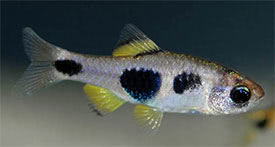
 Magyarul / Hungarian
Magyarul / Hungarian




- Scientific name: Enteromius jae
- Synonyms: Barbus jae (Boulenger, 1903)
- Common name: Jae Barb
- Group: Cyprinids
- Distribution: West Africa; Cameroon, Equatorial Guinea, Gabon, Republic of Congo and Democratic Republic of Congo
- Size: 3,5-4 cm
- Biotope: Found in slow-flowing, shallow forest streams and marshes with dense marginal vegetation. These black water streams are often brown colored due the decomposing organic matter and the lots of dried leaves. These waters are typically soft and weakly acidic.
- Social behavior: Due to its small size and shyness, it is not really suitable for most community tanks, but can be kept with other small sized fish, prefering similar conditions. It is advised to keep at least 8-10 species in a group.
- Diet: Omnivorous; In nature they feed on insect larvae and small crustaceans. In the aquarium they can be fed with live, frozen and flake foods too.
- Breeding: Quite easy
- Tank: Minimum 40 litres
- Population: 8-10 fish for 40 litres
- Decoration: They can also be kept in a heavily-planted, soft-water tank, but ideally they should be kept in a biotope aquarium. Decorate the tank with sandy substrate and driftwood roots and branches to provide plenty of shady spots. Use subdued lighting, and place some dried leaves into the tank to provide more natural environment. You could add some African plants that can survive under low light conditions.
- Temperature: 17-24 °C
- pH: 5.0-6.5
- Hardness: 1.0-5.0 dGH
- Lifespan: 3-5 years
Males are more brightly-colored, especially during breeding, while females tend to be duller and more plumper.
According to observations Enteromius jae is a seasonal spawner with breeding activity occuring over two periods each year from March to June and September to November. Even aquarium-bred fish did not deviate from this pattern of behaviour. Like many small cyprinids they are egg-scatterers and they exhibiting no parental care at all. In a biotope aquarium they will usually spawn, and it is possible that a small numbers of fry will survive, however if you want to save more fry, a separated aquarium is required. They can be bred in a small, dimly lighted tank, that filled with slightly acidic (pH 5-6), very soft (1-5 dGH°) water, and put a few clumps of Java moss in it, or place a handful of dried leaf litter to the bottom. Condition the adult pair or pairs for a couple of days with live foods, and place them into the breeding tank. Spawning usually begin in the evening hours, and can last for a couple of days. Unlike other barbs, this species appears not to actively hunt for eggs or the fry. The adult fish can be left in the aquarium until the first free-swimming fry are noticed, which should be within 7-10 days, and at this point the adults are best removed. On the first days the fry should be fed with powdered dry foods, and after 6-7 days they can be offered newly hatched brine shrimp.
https://www.fishbase.se/summary/11375
https://www.seriouslyfish.com/species/barbus-jae
https://www.aquariumglaser.de/en/fish-archives/barbus_jae_en-2
http://www.theaquariumwiki.com/wiki/Barbus_jae






